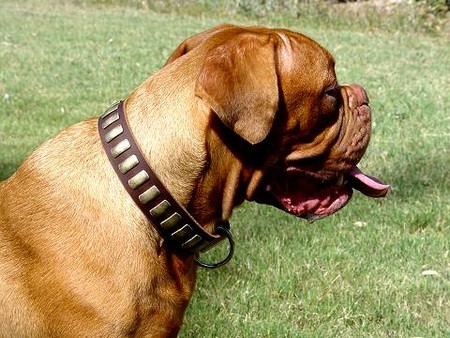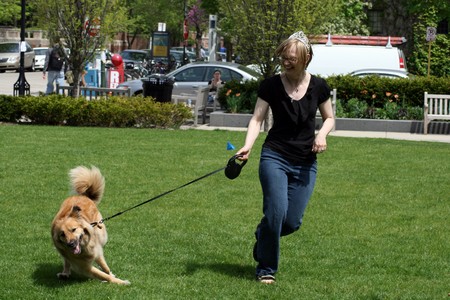“What should I wear?” Most parents of teenage girls have heard that wail just before the next question, “Can you take me to the mall?” Luckily, most dogs don’t want to go shopping, but they do need clothing (commonly called equipment) to help them act in a civilized manner.
Equipment can be quite confusing. There’s the “Goth” look, with pinch or spike collars and choke chains; there’s the “conservative” look, with normal flat collars or harnesses; and there’s also the “fashionable” look, complete with designer collars and leashes, even scarves and booties.
Sometimes people think choosing the right equipment will make their dog behave well. Sorry…it doesn’t work that way! Equipment can be compared to pen and paper or a computer keyboard. You can’t write without them, but they don’t write on their own.
Before you actually choose some equipment, let’s see how different gear works. Collars are the most important.

Collars
Choke chain collars
The most “popular” collar is a choke chain, often called a “training” collar. It works by choking the dog when he does something the handler doesn’t like—such as pulling on the leash. As far as I’m concerned, there’s very little about this collar to recommend it. It’s not even pretty! Inexperienced handlers usually have a great deal of trouble using it properly, and their dogs continue to pull while gasping and choking. The choke chain can injure your dog if you’re not careful, and you can actually harm his trachea through pulling or jerking. Another dog might injure him by catching a tooth in his collar during play, or your dog could harm himself by catching the collar on a fence and choking. Some experienced trainers find the choke chain useful, but many of us who originally used it have long since moved to other collars.
Pinch/spike/prong collars
A pinch, spike, or prong collar works by closing on the dog’s neck as he starts to pull on the leash. When he reaches a certain point, the prongs pinch the skin and cause discomfort. This in turn causes the dog to slow down. Whether the action of the collar causes actual pain or not depends on your outlook. I think it does, especially given that many dogs yelp when the collar tightens. A dog’s neck is not as delicate as ours are, but it isn’t made out of steel either (though when a dog is pulling you down the street it can feel like it). Both the choke chain and pinch collar use pain and discomfort to punish the dog for pulling. To me, using this type of collar is reminiscent of the now obsolete classroom practice of striking children with a ruler to discourage bad behavior.
Martingale collars
A martingale collar is designed like a pinch collar without the prongs, and therefore, without the pain. Another name for it is a ‘limited slip” collar. As a restraint device, it works well with dogs who aren’t really interested in investigating the world when you want to walk, but it doesn’t work well on dogs who really pull.
Regular (flat) collars
A regular (flat) collar is a nice article of clothing on which to hang your dog’s identification, and it’s useful to attach your leash to if your relationship is such that you and your dog walk together comfortably. However, it’s not much use as a training device.
Head collars
Another device is a head collar, which is really a halter that looks a lot like a halter for a horse. This collar gives you a lot of control over the dog’s head, and when you control the head, you pretty much control the dog. There are positive and negative aspects to the halter. Though you have a lot more control with this type of device, you need substantial leash savvy to use it properly. Pull too hard and you’ll twist the dog’s head back. Pull up, and his head will go with it. The other disadvantages are twofold: Both owners and dogs don’t like them much. The halter looks a bit like a muzzle, and passersby often shy away from a dog who is wearing one. (However, as they’ve become more popular, that reaction has lessened.) More importantly, many dogs object vehemently to wearing a head collar. They rub their muzzles on the ground and between your legs and sometimes can’t concentrate at all on what you’d like them to do. It’s probably like owning a very badly fitted pair of glasses that you must wear. Some dogs get used to the head collar right away, some take time, and some never do acclimate to wearing it.
Harnesses
There are a number of harnesses on the market. Many have a nice, fashionable look, and some are actually very useful. I like them because they avoid the neck area and distribute pressure evenly most of the time. However, harnesses that have a leash attachment on the back often almost encourage pulling—just look at how sled dogs pull! There are a few no-pull harnesses available; most work by applying pressure to the back of the dog’s front legs. Some work well, but many chafe under the legs.
As of this writing, there’s a new type of harness available that I’m enthusiastic about. The leash attachment is in the front, rather than on the dog’s back. This controls the opposition reflex so that when the dog pulls, he actually does a U-turn. It’s very humane and causes no pain, either to the dog or to you. I think it enhances the dog/guardian relationship. Though it’s best if you get instructions on how to use this type of harness, it’s virtually impossible to injure a dog with it.
Leashes

I have just two criteria for a leash: It must be comfortable to hold (soft and pliable), and it cannot be a retractable leash. Many people do use retractable leashes, but they aren’t suitable for training. Indeed, they can actually encourage pulling on the leash, and they can be dangerous if they get tangled around your legs, your dog’s legs, strangers’ legs, or around trees. I use a short, 2- to 3-foot leash for training a dog to walk next to me, a 6-foot leash for most other work, and a long line (30 feet) to teach a dog to come when called.
If you have a small dog, pretty much any material will do, as your dog is not likely to pull too hard. However, for medium to small dogs, I suggest leather or a soft nylon that won’t dig into your hands. I don’t recommend chain leashes except in cases where the dog is biting at or chewing through his normal leash. They’re heavy and cumbersome, and they interfere with good communication. When you hold your leash, try not to put the loop around your wrist. If your dog does pull hard, it can injure your hand. Instead, make an “accordion” out of the excess leash, and hold it in your hand.